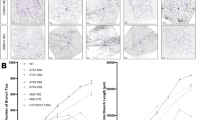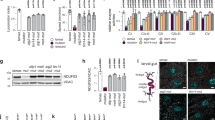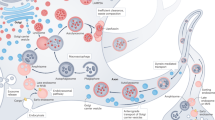Abstract
Polyglutamine pathologies are neurodegenerative diseases that manifest both general polyglutamine toxicity and mutant protein-specific effects. Dentatorubral-pallidoluysian Atrophy (DRPLA) is one of these disorders caused by mutations in the Atrophin-1 protein. We have generated several models for DRPLA in Drosophila and analysed the mechanisms of cellular and organism toxicity. Our genetic and ultrastructural analysis of neurodegeneration suggests that autophagy may have a role in cellular degeneration when polyglutamine proteins are overexpressed in neuronal and glial cells. Clearance of autophagic organelles is blocked at the lysosomal level after correct fusion between autophagosomes and lysosomes. This leads to accumulation of autofluorescent pigments and proteinaceous residues usually degraded by the autophagy–lysosome system. Under these circumstances, further pharmacological and genetic induction of autophagy does not rescue neurodegeneration by polyglutamine Atrophins, in contrast to many other neurodegenerative conditions. Our data thus provide a crucial insight into the specific mechanism of a polyglutamine disease and reveal important differences in the role of autophagy with respect to other diseases of the same family.
Similar content being viewed by others
Log in or create a free account to read this content
Gain free access to this article, as well as selected content from this journal and more on nature.com
or
Abbreviations
- DRPLA:
-
Dentatorubral-pallidoluysian Atrophy
- polyQ:
-
polyglutamine
References
Ross CA . Polyglutamine pathogenesis: emergence of unifying mechanisms for Huntington's disease and related disorders. Neuron 2002; 35: 819–822.
Arrasate M, Mitra S, Schweitzer ES, Segal MR, Finkbeiner S . Inclusion body formation reduces levels of mutant huntingtin and the risk of neuronal death. Nature 2004; 431: 805–810.
Mizushima N, Levine B, Cuervo AM, Klionsky DJ . Autophagy fights disease through cellular self-digestion. Nature 2008; 451: 1069–1075.
Nixon RA . Autophagy in neurodegenerative disease: friend, foe or turncoat? Trends Neurosci 2006; 29: 528–535.
Chen HK, Fernandez-Funez P, Acevedo SF, Lam YC, Kaytor MD, Fernandez MH et al. Interaction of Akt-phosphorylated ataxin-1 with 14-3-3 mediates neurodegeneration in spinocerebellar ataxia type 1. Cell 2003; 113: 457–468.
Emamian ES, Kaytor MD, Duvick LA, Zu T, Tousey SK, Zoghbi HY et al. Serine 776 of ataxin-1 is critical for polyglutamine-induced disease in SCA1 transgenic mice. Neuron 2003; 38: 375–387.
Warrick JM, Morabito LM, Bilen J, Gordesky-Gold B, Faust LZ, Paulson HL et al. Ataxin-3 suppresses polyglutamine neurodegeneration in Drosophila by a ubiquitin-associated mechanism. Mol Cell 2005; 18: 37–48.
Marsh JL, Thompson LM . Drosophila in the study of neurodegenerative disease. Neuron 2006; 52: 169–178.
Romero E, Cha GH, Verstreken P, Ly CV, Hughes RE, Bellen HJ et al. Suppression of neurodegeneration and increased neurotransmission caused by expanded full-length huntingtin accumulating in the cytoplasm. Neuron 2008; 57: 27–40.
Naito H, Oyanagi S . Familial myoclonus epilepsy and choreoathetosis: hereditary dentatorubral-pallidoluysian atrophy. Neurology 1982; 32: 798–807.
Nagafuchi S, Yanagisawa H, Ohsaki E, Shirayama T, Tadokoro K, Inoue T et al. Structure and expression of the gene responsible for the triplet repeat disorder, dentatorubral and pallidoluysian atrophy (DRPLA). Nature genetics 1994; 8: 177–182.
Erkner A, Roure A, Charroux B, Delaage M, Holway N, Core N et al. Grunge, related to human Atrophin-like proteins, has multiple functions in Drosophila development. Development 2002; 129: 1119–1129.
Shen Y, Lee G, Choe Y, Zoltewicz JS, Peterson AS . Functional architecture of atrophins. J Biol Chem 2007; 282: 5037–5044.
Zhang S, Xu L, Lee J, Xu T . Drosophila atrophin homolog functions as a transcriptional corepressor in multiple developmental processes. Cell 2002; 108: 45–56.
Zoltewicz JS, Stewart NJ, Leung R, Peterson AS . Atrophin 2 recruits histone deacetylase and is required for the function of multiple signaling centers during mouse embryogenesis. Development 2004; 131: 3–14.
Charroux B, Freeman M, Kerridge S, Baonza A . Atrophin contributes to the negative regulation of epidermal growth factor receptor signaling in Drosophila. Dev Biol 2006; 291: 278–290.
Nucifora Jr FC, Ellerby LM, Wellington CL, Wood JD, Herring WJ, Sawa A et al. Nuclear localization of a non-caspase truncation product of atrophin-1, with an expanded polyglutamine repeat, increases cellular toxicity. J Biol Chem 2003; 278: 13047–13055.
Wood JD, Nucifora Jr FC, Duan K, Zhang C, Wang J, Kim Y et al. Atrophin-1, the dentato-rubral and pallido-luysian atrophy gene product, interacts with ETO/MTG8 in the nuclear matrix and represses transcription. J Cell Biol 2000; 150: 939–948.
Karres JS, Hilgers V, Carrera I, Treisman J, Cohen SM . The conserved microRNA miR-8 tunes atrophin levels to prevent neurodegeneration in Drosophila. Cell 2007; 131: 136–145.
Steffan JS, Bodai L, Pallos J, Poelman M, McCampbell A, Apostol BL et al. Histone deacetylase inhibitors arrest polyglutamine-dependent neurodegeneration in Drosophila. Nature 2001; 413: 739–743.
Holmberg CI, Staniszewski KE, Mensah KN, Matouschek A, Morimoto RI . Inefficient degradation of truncated polyglutamine proteins by the proteasome. EMBO J 2004; 23: 4307–4318.
Venkatraman P, Wetzel R, Tanaka M, Nukina N, Goldberg AL . Eukaryotic proteasomes cannot digest polyglutamine sequences and release them during degradation of polyglutamine-containing proteins. Mol Cell 2004; 14: 95–104.
Scott RC, Schuldiner O, Neufeld TP . Role and regulation of starvation-induced autophagy in the Drosophila fat body. Dev Cell 2004; 7: 167–178.
Ravikumar B, Vacher C, Berger Z, Davies JE, Luo S, Oroz LG et al. Inhibition of mTOR induces autophagy and reduces toxicity of polyglutamine expansions in fly and mouse models of Huntington disease. Nat Genet 2004; 36: 585–595.
Berger Z, Ravikumar B, Menzies FM, Oroz LG, Underwood BR, Pangalos MN et al. Rapamycin alleviates toxicity of different aggregate-prone proteins. Hum Mol Genet 2006; 15: 433–442.
Sarkar S, Krishna G, Imarisio S, Saiki S, O’Kane CJ, Rubinsztein DC . A rational mechanism for combination treatment of Huntington's disease using lithium and rapamycin. Hum Mol Genet 2008; 17: 170–178.
Wang T, Lao U, Edgar BA . TOR-mediated autophagy regulates cell death in Drosophila neurodegenerative disease. J Cell Biol 2009; 186: 703–711.
Scott RC, Juhasz G, Neufeld TP . Direct induction of autophagy by Atg1 inhibits cell growth and induces apoptotic cell death. Curr Biol 2007; 17: 1–11.
Degtyarev M, De Maziere A, Orr C, Lin J, Lee BB, Tien JY et al. Akt inhibition promotes autophagy and sensitizes PTEN-null tumors to lysosomotropic agents. J Cell Biol 2008; 183: 101–116.
Venkatachalam K, Long AA, Elsaesser R, Nikolaeva D, Broadie K, Montell C . Motor deficit in a Drosophila model of mucolipidosis type IV due to defective clearance of apoptotic cells. Cell 2008; 135: 838–851.
Nezis IP, Simonsen A, Sagona AP, Finley K, Gaumer S, Contamine D et al. Ref(2)P, the Drosophila melanogaster homologue of mammalian p62, is required for the formation of protein aggregates in adult brain. J Cell Biol 2008; 180: 1065–1071.
Bjorkoy G, Lamark T, Brech A, Outzen H, Perander M, Overvatn A et al. p62/SQSTM1 forms protein aggregates degraded by autophagy and has a protective effect on huntingtin-induced cell death. J Cell Biol 2005; 171: 603–614.
Cuervo AM, Dice JF, Knecht E . A population of rat liver lysosomes responsible for the selective uptake and degradation of cytosolic proteins. J Biol Chem 1997; 272: 5606–5615.
Settembre C, Fraldi A, Jahreiss L, Spampanato C, Venturi C, Medina D et al. A block of autophagy in lysosomal storage disorders. Hum Mol Genet 2008; 17: 119–129.
Sato T, Miura M, Yamada M, Yoshida T, Wood JD, Yazawa I et al. Severe neurological phenotypes of Q129 DRPLA transgenic mice serendipitously created by en masse expansion of CAG repeats in Q76 DRPLA mice. Hum Mol Genet 2009; 18: 723–736.
Schilling G, Wood JD, Duan K, Slunt HH, Gonzales V, Yamada M et al. Nuclear accumulation of truncated atrophin-1 fragments in a transgenic mouse model of DRPLA. Neuron 1999; 24: 275–286.
Razi M, Chan EY, Tooze SA . Early endosomes and endosomal coatomer are required for autophagy. J Cell Biol 2009; 185: 305–321.
Tamura T, Sone M, Yamashita M, Wanker EE, Okazawa H . Glial cell lineage expression of mutant ataxin-1 and huntingtin induces developmental and late-onset neuronal pathologies in Drosophila models. PLoS One 2009; 4: e4262.
Kretzschmar D, Tschape J, Bettencourt Da Cruz A, Asan E, Poeck B, Strauss R et al. Glial and neuronal expression of polyglutamine proteins induce behavioral changes and aggregate formation in Drosophila. Glia 2005; 49: 59–72.
Lievens JC, Iche M, Laval M, Faivre-Sarrailh C, Birman S . AKT-sensitive or insensitive pathways of toxicity in glial cells and neurons in Drosophila models of Huntington's disease. Hum Mol Genet 2008; 17: 882–894.
Custer SK, Garden GA, Gill N, Rueb U, Libby RT, Schultz C et al. Bergmann glia expression of polyglutamine-expanded ataxin-7 produces neurodegeneration by impairing glutamate transport. Nat Neurosci 2006; 9: 1302–1311.
Boillee S, Vande Velde C, Cleveland DW . ALS: a disease of motor neurons and their nonneuronal neighbors. Neuron 2006; 52: 39–59.
Hayashi Y, Kakita A, Yamada M, Koide R, Igarashi S, Takano H et al. Hereditary dentatorubral-pallidoluysian atrophy: detection of widespread ubiquitinated neuronal and glial intranuclear inclusions in the brain. Acta Neuropathologica 1998; 96: 547–552.
Yamada M, Sato T, Tsuji S, Takahashi H . Oligodendrocytic polyglutamine pathology in dentatorubral-pallidoluysian atrophy. Ann Neurol 2002; 52: 670–674.
Montrasio S, Mlodzik M, Fanto M . A new allele uncovers the role of echinus in the control of ommatidial rotation in the Drosophila eye. Dev Dyn 2007; 236: 2936–2942.
Hardie RC . Voltage-sensitive potassium channels in Drosophila photoreceptors. J Neurosci 1991; 11: 3079–3095.
Acknowledgements
We thank Gabriele Schilling, David Borchelt, Helen McNeill, Joe Bateman, Tor Erik Rusten, Serge Birman, Thomas Neufeld, the DHSB, DGRC and Bloomington for reagents and stocks; Julien Royet, Sharon Tooze and Ana Cuervo for discussions; Aïcha Ouane for technical assistance; and Joy Burchell and Steve Catchpole for help with the phosphoimager. MF is supported by the Italian Telethon Foundation with a career development award and is an Assistant Telethon Scientist. This work was also supported by the European Union Marie Curie European Reintegration Grant 505739, by Fondazione Cariplo and Compagnia di San Paolo grants to MF, and funds from the Centre National de la Recherche Scientifique to BC and the KCL School of Biomedical and Health Sciences to MF.
Author information
Authors and Affiliations
Corresponding authors
Ethics declarations
Competing interests
The authors declare no conflict of interest.
Additional information
Edited by E Baehrecke
Supplementary Information accompanies the paper on Cell Death and Differentiation website
Supplementary information
Rights and permissions
About this article
Cite this article
Nisoli, I., Chauvin, J., Napoletano, F. et al. Neurodegeneration by polyglutamine Atrophin is not rescued by induction of autophagy. Cell Death Differ 17, 1577–1587 (2010). https://doi.org/10.1038/cdd.2010.31
Received:
Revised:
Accepted:
Published:
Issue date:
DOI: https://doi.org/10.1038/cdd.2010.31
Keywords
This article is cited by
-
Fat cadherins in mouse models of degenerative ataxias
Scientific Reports (2019)
-
Frontotemporal dementia: insights into the biological underpinnings of disease through gene co-expression network analysis
Molecular Neurodegeneration (2016)
-
Live imaging of muscle histolysis in Drosophila metamorphosis
BMC Developmental Biology (2016)
-
Lazarillo-related Lipocalins confer long-term protection against type I Spinocerebellar Ataxia degeneration contributing to optimize selective autophagy
Molecular Neurodegeneration (2015)
-
Differential Degradation of Full-length and Cleaved Ataxin-7 Fragments in a Novel Stable Inducible SCA7 Model
Journal of Molecular Neuroscience (2012)



